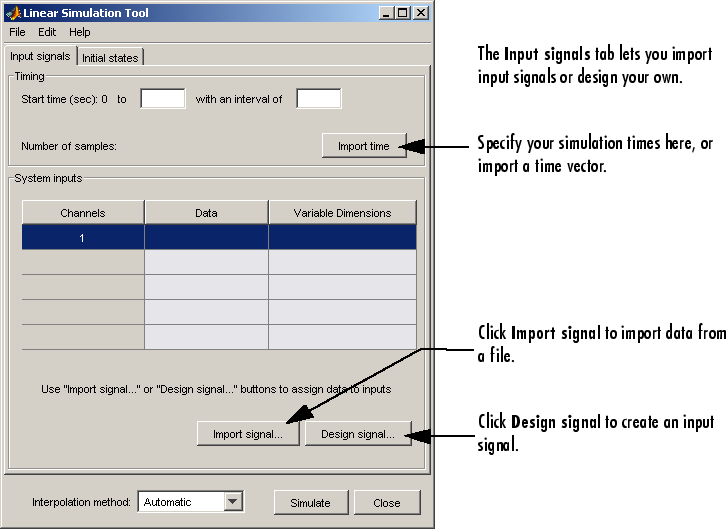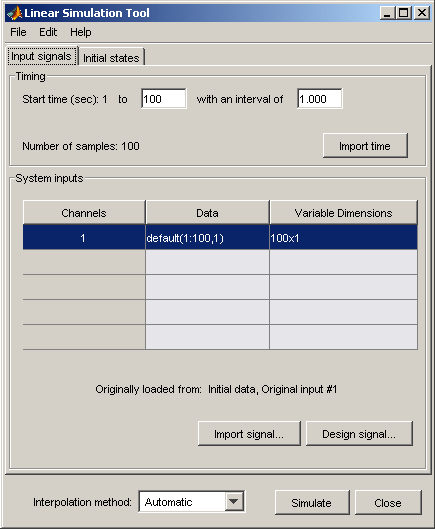Simuler des modèles avec des entrées et des conditions initiales arbitraires
Qu’est-ce que Linear Simulation Tool ?
Vous pouvez utiliser Linear Simulation Tool pour simuler des modèles linéaires avec des signaux d'entrée et des conditions initiales arbitraires.
Linear Simulation Tool vous permet de faire ce qui suit :
Importer des signaux d'entrée à partir de l'espace de travail de MATLAB®.
Importer des signaux d'entrée à partir d'un fichier MAT, d'une feuille de calcul Microsoft® Excel®, d'un fichier plat ASCII, d'un fichier CSV (Comma Separated Variable) ou d'un fichier texte.
Générer des signaux d'entrée arbitraires sous la forme d'une onde sinusoïdale, d'une onde carrée, d'une fonction indicielle ou d'un bruit blanc.
Spécifier les états initiaux pour les modèles de représentation d'état.
Les états initiaux par défaut sont zéro.
Lancement de Linear Simulation Tool
Pour ouvrir Linear Simulation Tool, faites l'une des choses suivantes :
Dans Linear System Analyzer, faites un clic droit sur le graphique et sélectionnez Plot Types > Linear Simulation.
Utilisez la fonction
lsimà l'invite de MATLAB :lsim(modelname)
Dans la fenêtre Figure de MATLAB, faites un clic droit sur un tracé de réponse et sélectionnez Input data.
Utilisation de Linear Simulation Tool
Linear Simulation Tool contient deux onglets, Input signals et Initial states.
Après avoir ouvert Linear Simulation Tool (comme indiqué dans Lancement de Linear Simulation Tool), suivez les étapes suivantes pour simuler votre modèle :
Cliquez sur l'onglet Input signals, s'il n'est pas affiché.

Dans le champ Timing, spécifiez le vecteur temps de la simulation en effectuant l'une des opérations suivantes :
Importez le vecteur temps en cliquant sur Import time.
Saisissez le temps final et le pas d'échantillonnage en secondes. Le temps de début est réglé sur
0seconde(s).
Spécifiez le signal d'entrée en effectuant l'une des opérations suivantes :
Cliquez sur Import signal pour l'importer de l'espace de travail de MATLAB ou d'un fichier. Pour plus d’informations, consultez Importation des signaux d'entrée.
Cliquez sur Design signal pour créer vos propres entrées. Pour plus d’informations, consultez Concevoir des signaux d'entrée.
Si vous disposez d'un modèle de représentation d'état et que vous souhaitez spécifier les conditions initiales, cliquez sur l'onglet Initial states. Par défaut, tous les états initiaux sont définis sur zéro.
Vous pouvez soit entrer des valeurs d'état dans la colonne Initial value, ou importer des valeurs en cliquant sur Import state vector. Pour plus d’informations sur les états initiaux, consultez Spécification des conditions initiales.

Pour un modèle continu, sélectionnez l'une des méthodes d'interpolation proposées dans la liste Interpolation method et listées ci-dessous, à utiliser par le solveur de simulation :
Bloqueur d'ordre zéro
Bloqueur du premier ordre (interpolation linéaire)
Automatique (Linear Simulation Tool sélectionne automatiquement un bloqueur d'ordre zéro ou du premier ordre, en fonction de la régularité de l'entrée)
Remarque
La méthode d'interpolation n'est pas utilisée lors de la simulation de modèles discrets.
Cliquez sur Simulate.
Importation des signaux d'entrée
Vous pouvez importer des signaux d'entrée à partir de l'espace de travail de MATLAB après avoir ouvert Linear Simulation Tool (voir Lancement de Linear Simulation Tool). Vous pouvez aussi importer des entrées à partir d'un fichier MAT, d'une feuille de calcul Microsoft Excel, d'un fichier plat ASCII, d'un fichier CSV (Comma-Separated Variable) ou d'un fichier texte.
Pour plus d'informations sur la création de vos propres entrées, voir Concevoir des signaux d'entrée. Pour une présentation sur l'utilisation de Linear Simulation Tool, voir Utilisation de Linear Simulation Tool.
Pour importer un ou plusieurs signaux d'entrée :
Dans Linear Simulation Tool, cliquez sur l'onglet Input signals, s'il n'est pas affiché.
Spécifiez la durée de la simulation dans le champ Timing.
Sélectionnez une ou plusieurs lignes pour les canaux d'entrée que vous souhaitez importer. La figure suivante montre un exemple avec deux canaux sélectionnés.

Cliquez sur Import signal pour ouvrir la boîte de dialogue « Data Import ». La figure suivante présente un exemple de cette boîte de dialogue.

Dans la liste Import from, sélectionnez la source des signaux d'entrée. Il peut s'agir de l'un des éléments suivants :
WorkspaceMAT fileXLS fileCSV fileASCII file
Sélectionnez les données que vous souhaitez importer. La boîte de dialogue d'importation des données contient différentes options en fonction du format de la source que vous avez sélectionné.
Cliquez sur Import.
Pour un exemple d'importation de signaux d'entrée, voir ce qui suit :
Exemple : Chargement des entrées à partir d'une feuille de calcul Microsoft Excel
Pour charger les entrées d'une feuille de calcul Microsoft Excel (XLS) :
Dans Linear Simulation Tool, cliquez sur Import signal dans l'onglet Input signals pour ouvrir la boîte de dialogue « Data Import ».
Sélectionnez XLS file dans la liste Import from.
Cliquez sur Browse.
Sélectionnez le fichier que vous voulez importer et cliquez sur Open. Cette opération permet d'alimenter la boîte de dialogue d'importation des données avec les données de la feuille de calcul Microsoft Excel.

Exemple : Importation d'entrées à partir de l'espace de travail
Pour charger un signal d'entrée à partir de l'espace de travail de MATLAB :
Saisissez ce code pour ouvrir un tracé de réponse avec un système de second ordre :
s=tf('s'); ss=(s+2)/(s^2+3*s+2); lsim(ss,randn(100,1),1:100);Faites un clic droit sur arrière plan du tracé et sélectionnez Input data.

Ceci ouvre Linear Simulation Tool avec des données d'entrée par défaut.

Créez un signal d'entrée pour votre système dans la fenêtre de commande de MATLAB comme suit :
new_signal=[-3*ones(1,20) 2*ones(1,30) 0.5*ones(1,50)]';
Dans Linear Simulation Tool, cliquez sur Import signal.
Dans la boîte de dialogue d'importation des données, cliquez sur Assign columns pour affecter la première colonne du signal d'entrée au canal sélectionné.

Cliquez sur Import. Ceci importe le nouveau signal dans Linear Simulation Tool.

Cliquez sur Simulate pour voir la réponse de votre système de second ordre au signal importé.

Concevoir des signaux d'entrée
Vous pouvez générer des signaux d'entrée arbitraires sous la forme d'une onde sinusoïdale, d'une onde carrée, d'une fonction indicielle ou d'un bruit blanc après avoir ouvert Linear Simulation Tool (voir Lancement de Linear Simulation Tool).
Pour plus d'informations sur l'importation d'entrées depuis l'espace de travail de MATLAB ou à partir d'un fichier, voir Importation des signaux d'entrée. Pour une présentation sur l'utilisation de Linear Simulation Tool, voir Utilisation de Linear Simulation Tool.
Pour concevoir un ou plusieurs signaux d'entrée :
Dans Linear Simulation Tool, cliquez sur l'onglet Input signals, s'il n'est pas affiché.
Spécifiez la durée de la simulation dans le champ Timing. Le pas d'échantillonnage (en secondes) est utilisé pour évaluer le signal d'entrée que vous allez concevoir dans les étapes ultérieures de cette procédure.
Sélectionnez une ou plusieurs lignes pour les canaux de signaux que vous souhaitez concevoir. La figure suivante montre un exemple avec deux canaux sélectionnés.

Cliquez sur Design signal pour ouvrir la boîte de dialogue « Signal Designer ». La figure suivante présente un exemple de la boîte de dialogue « Signal Designer ».

Dans la liste Signal type, sélectionnez le type de signal que vous souhaitez créer. Il peut s'agir de l'un des éléments suivants :
Sine waveSquare waveStep functionWhite noise
Spécifiez les caractéristiques du signal. La boîte de dialogue « Signal Designer » contient différentes options en fonction du type de signal que vous avez sélectionné.
Cliquez sur Insert. Cette action permet d'importer le nouveau signal dans Linear Simulation Tool.
Cliquez sur Simulate dans Linear Simulation Tool pour afficher la réponse du système.
Spécification des conditions initiales
Si votre système est exprimé sous forme de représentation d'état, vous pouvez saisir ou importer des états initiaux après avoir ouvert le programme Linear Simulation Tool (voir Lancement de Linear Simulation Tool).
Pour une présentation sur l'utilisation de Linear Simulation Tool, voir Utilisation de Linear Simulation Tool.
Vous pouvez également importer des états initiaux à partir de l'espace de travail de MATLAB.
Pour importer un ou plusieurs états initiaux :
Dans Linear Simulation Tool, cliquez sur l'onglet Initial states, s'il n'est pas déjà affiché.
Dans la liste Selected system (Système sélectionné), sélectionnez le système pour lequel vous souhaitez spécifier les conditions initiales.
Vous pouvez soit entrer des valeurs d'état dans la colonne Initial value ou les importer depuis l'espace de travail de MATLAB en cliquant sur Import state vector. La figure suivante montre un exemple de la fenêtre d'importation :

Remarque
Pour n-états, votre vecteur de condition initiale doit avoir n entrées.
Après avoir spécifié les états initiaux, cliquez sur Simulate dans Linear Simulation Tool pour afficher la réponse du système.